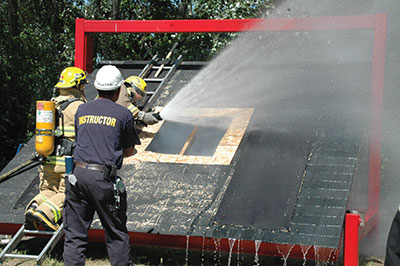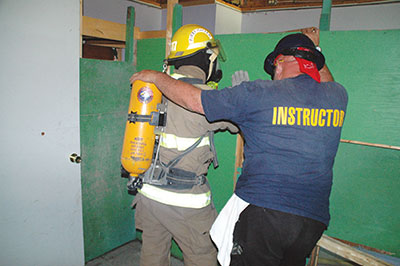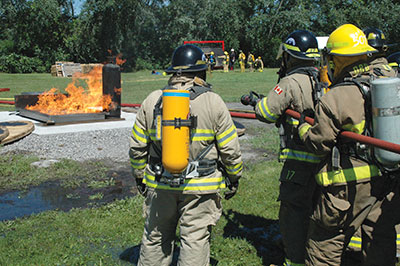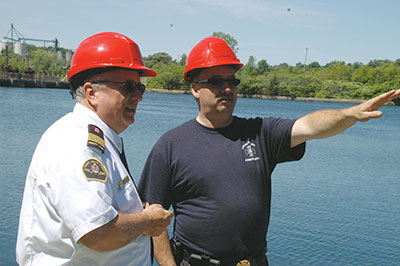
Department news
News
Building partnerships
For Prince Edward County Deputy Chief Rob Rutter, the motto, If you build it, they will come, rings as true as the blood, sweat and persistence that has led to expansion and full-on programming at the region’s fire training centre.
June 4, 2013
By
Laura King
For Prince Edward County Deputy Chief Rob Rutter, the motto, If you build it, they will come, rings as true as the blood, sweat and persistence that has led to expansion and full-on programming at the region’s fire training centre.
 |
|
| Students are run through the ventilation prop during Module A training, which gives them nine sign-offs toward their Firefighter-1 certification. Photos by LAURA KING
|
The Hastings and Prince Edward Counties Fire Training Complex in Quinte West, Ont., is a shining example – literally, with its two new (or, rather, gently used) pumpers – of perseverance and community partnerships.
Few fire departments outside major centres enjoy the luxury of fully equipped training facilities; many rural fire departments have opted for online training as funds for firefighters to travel to provincial fire schools are scarce.
But for the Hastings-Prince Edward Mutual Fire Aid Association, which comprises 17 member fire departments, ingenuity trumped frustration and the original training centre – with a tower and classrooms – has been transformed into a firefighter’s field of dreams.
“If this facility were going to survive we knew we had to bring it back to life because it was slowly dwindling,” says Rick Caddick, the fire chief in Stirling-Rawdon, a picturesque community that supports its fire department and loves its hockey – Stirling-Rawdon was the winner of the Kraft Hockeyville contest in 2012.
“It was cheaper for departments to send the guys here to be trained than it is to send them to Gravenhurst to the Ontario Fire College,” Caddick says. “We don’t have to pay their mileage, they go home at night, and they’re training with men and women they’re going to work with every day.”
“And,” says Rutter, “it fits hand in hand with what’s happening in the province; the fire college announced [in 2012] that it’s delivering more courses off site than at the OFC.”
Still, says Caddick, the training ground is a well-kept secret. “There are still a lot of guys saying, we didn’t know that it’s here, and that it’s awesome.”
 |
|
| An instructor prepares a firefighter whose mask is blacked out to navigate the maze during Module A training at the Hastings and Prince Edward Counties Fire Training Complex in Quinte West, Ont.
|
The training centre was the brainchild of the mutual-aid association back in the 1980s. The then City of Trenton (now Quinte West) provided the land on a 25-year lease for $1 a year, and CFB Trenton made a financial donation. Construction started on the tower in 1984 and a two-storey confined-space training module was added through a donation from Proctor and Gamble. In 2011, the Quinte West Fire Department donated a 1992 E-One pumper, and an outdoor shelter where firefighters can practice and gear up was built by a local contractor.
Back before municipal amalgamation in 1997, there were 30 fire departments in the mutual-aid association; members held barbeques and sold hats to raise money to build the training tower. The classroom building was added a few years later.
“That was the extent of the bricks and mortar for several years,” Caddick says. “Up to that point we ran more information-type courses; we weren’t accredited, but they were certificate courses.”
Then in 2008, says Rutter, the mutual-aid association and the facility’s board members knew they needed to do more to keep firefighters trained and equipped.
“This is before the Ontario Fire College had made the decision to get the courses out in the community,” Caddick says, “so we brought [former instructor] Wayne McIsaac down from the college and he agreed to hold a Module A course here for one year and allow us to do live fire training here in the cans, and from that point forward it has grown. We’re doing legislation 101 here and fire-scene assessment is filled every year; this is the fifth year of Module A and we’re filled to capacity every year.”
Originally, the training centre’s board members looked after the details for the courses – hay and palates, drinking water, lunches, and whatever else was needed.
“As it has progressed,” says Caddick, “we certainly have become more proficient at putting the course on. There were usually four or five of us here working and running to get equipment; now it’s much easier because the support work that needs to be done – the hay is here, palates are here – because we have appointed a facility manager who looks after cutting the grass and that everything’s ready to go. We have worker bees.”
The training centre runs two trainer facilitator presentation skills courses each year, after which successful candidates can deliver training to their own firefighters and sign them off on skills. The first pump operations course was offered in September 2012, and fire-prevention officer courses begin this year. In October, the centre will run its first RIT/firefighter self-rescue program.
Rutter says the success of the training is due solely to the commitment of the surrounding departments.
“We have never done without,” Rutter says. “We put the word out that we need a pumper and someone pulls one out of service. We are becoming more self sufficient.”
The facility’s two recently donated pumpers – a City of Trenton 1990 E-One and a City of Belleville 1992 E-One – are welcome additions.
And now, the mutual-aid society is raising money through tickets sales on a $65,000, 2013 Ford Lariat to build a three-bay fire station for the training centre’s apparatuses.
 |
|
| Participants practice nozzle-and-hoseline skills during a Module A class in June 2012; there were 25 students in the class ranging in age from 20 to 45, all volunteer firefighters.
|
In addition to the training tower, the classroom building, the shelter and the trucks, the facility includes a maze for training on entrapments, a ventilation prop, a new (in 2012) Bullex propane fire-hose training system and two large steel tanks used to teach direct and indirect fire attack, thermal layering, mechanical ventilation and fire behaviour.
Last summer, after a fair bit of negotiating, the training centre hosted its first auto extrication course, supported by the Burlington Fire Department because the Ontario Fire College no longer offers extrication programs.
Burlington is well known for its award-winning auto extrication team, and its chief training officer, Bill Hammond, was instrumental in organizing the course.
“We go to more vehicle extrications than house fires,” Rutter said. “And Burlington donated a set of heavy hydraulics, so now we have our own.”
AJ Stone donated RIT packs and air cylinders after another donor provided facemasks and regulators, and has given the centre an MSA carbon monoxide and hydrogen cyanide detector for monitoring the atmosphere on the fire ground; M&L Supply “left us some nice hose and supply lines,” Rutter said. Darch Fire recently donated a hose reel for the centre’s Holmatro heavy rescue tools.
“The suppliers have been extremely supportive of this facility and this helps us immensely,” Caddick says.
In 2011, when a Module A program was running, organizers had erected tents to shelter the students while they geared up; the wind came up, the tents came down and a $24,000 shelter was born. RAD Home Improvement – which is owned by a facility committee member – donated time and labour, and the large structure now provides dry ground and weather protection for program participants.
The Bullex fire-hose training system is environmentally friendly – it uses propane rather than oils and fuels. All the propane lines and tanks were donated and installed by Tyendinaga Propane.
“It’s just talking to these people and communicating with them,” Rutter says.
“It’s about partnerships,” Caddick agrees. “Everybody brings something to the table.”
In addition, the mutual-aid group plans to remove the electric heat out of the classroom building to lower operating costs.
The training facility is accessible by local fire departments, which means as many as 1,000 firefighters can take advantage of it in a year.
“Any department can use it any time as long as we’re not running courses,” Caddick says. “We also have arrangements with CFB Trenton and they use it for specialized training; Proctor & Gamble uses it for confined-space training.”
 |
|
| Deputy Chief Rob Rutter of Prince Edward County and Chief Rick Caddick of Stirling-Rawdon discuss the potential for ice-water training at the region’s training centre, which has expanded in the last few years, primarily through donations and elbow grease provided by volunteer firefighters and area businesses. |
Rutter says the key to the success of the training centre is the passion of the committee members and their connections in the community.
“Every one of us brings our own thing to the table; for example, president Chuck Naphan is with Public Works so he has the contacts with the concrete and the gravel people, and everyone just comes together.”
And every department makes some kind of commitment to the facility; for example, two of the training centre’s in-house instructors – Bob Downey and Jim Young – are from Prince Edward Fire.
“That’s one of the things that Wayne McIsaac emphasized,” Rutter says. “You have to get your own instructors so you become more self-sufficient.”
Each fire department pays dues to the mutual-aid association to cover the cost of mowing, plowing and utilities.
At the Module A session in June 2012, instructors Downey, Young and retired Belleville firefighter Peter Helm ran the course along with four instructors from the fire college.
The Module A program – an Ontario Fire College accredited course – gives firefighters nine sign-offs from component one of the Ontario firefighter curriculum. Module B was delivered in October 2012, after which students who had the required sign-offs could write their Firefighter-1 test.
“Firefighters today aren’t going to spend the time to attend unless they get accreditation,” Caddick says.
“They are permitted to write their exam if they so choose; some don’t want to but it’s an option they have; last October we had 40 people writing exams in this room, and they are all taking time off work – they are volunteers. There is a minimum of 40 hours of pre-course work that has to go into this. They get the binders in advance and the first thing the instructors will do is gather up binders and go through the pre-course work. This is a commitment these firefighters are making.”
As Rutter says, that spirit of volunteerism is what drives those involved in the training centre to go to the businesses in the community for support.
“This facility has been here for 28 years,” he says. “But in the last few, we’ve started putting time and money into it. Without a dream nothing’s going to happen. Without goals you’re not going to win the game.”
Print this page